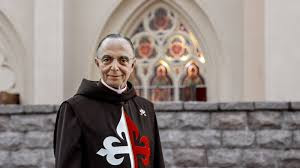The Traditionalist Network.
I've been thinking and reading articles filled with ominous anticipation over the Pan Amazon Synod. Lay people are gathering in Rome to pray for the protection of St. Michael against diabolic manipulation of the synod. Likewise priests are praying a special exorcism prayer on the eve of the feast of St. Michael - praying at a special time, and priests around the world are invited to join in. I'm not sure who initiated these things, but it surely can't hurt to pray in this way. It's a good thing, very similar to Cardinal Burke and Bishop Schneider's initiative to pray the rosary and fast for the Church before the synod. Nothing wrong with that.
I just do not understand the sense of panic which seems to underlie these efforts. It seems to me many are projecting fears and suspicions onto the synod based on the working draft, or proposals to be discussed. It seems to me all the conspiracy theories and contention since the Vatican Council is reaching a crescendo these days.
I'm always curious as to how and why this came to be. I've been reading some of the rad-trad sites and linking together much of the post-conciliar-anti-papal propaganda. What attracts faithful Catholics to these 'movements'? They are movements within the Church, not schismatic groups, but rather close to schism. They are well funded in both North and South America.
Traditionalists forming a remnant.
I think people - even people like me - are attracted to the traditional devotions these groups embody. I have gone to some of their websites to get information on saints and the Blessed Virgin under her various titles. Their literature is very good. They also supply prayers and devotionals no longer in usage among contemporary Catholics. Their devotion to Fatima and the Rosary is a sort of imprimatur that their apostolate is indeed faithful to the Holy Father and the Magisterium. They also attract many devout Catholics because they are actively pro-life and against such things as same sex marriage. They demonstrate and are often more aggressive in these apostolates than some other groups. They are also very much - even literally - cloaked in religion. It is related to clericalism, which Pope Francis so often warns against, stating more recently: "Clericalism confuses priestly 'service' with priestly 'power.'" (Therefore, is it any wonder these types resist the Holy Father?)
Plinio Corrêa de Oliveira 1968
Before reading his article, I wasn't aware of the site - Pan-Amazon Synod Watch. The name of the site is reminiscent of the sede site, "Novus Ordo Watch" - a site I believe many of the rad-trad sites are in agreement with. TFP and its 'affiliates' is a network which has been operating since the Council, and the influence of Plinio Corrêa de Oliveira cannot be underestimated.
The Godfather of the Synod Resistance
Oliveira is in many ways the godfather of the resistance to the Amazon synod; he was just as much a critic of Pope John Paul II’s outreach to the indigenous communities of the region as his organization is of Pope Francis today.
At age 24, Oliveira became the youngest congressman in the history of Brazil. After creating the Catholic Electoral League to mobilize traditionalist Catholics, he was a trenchant critic of the pan-continental bishops’ organization created in the 1950s, the Latin American Episcopal Council (CELAM).
Oliveira was in Rome in the 1960s during the Second Vatican Council and described it as “a point in history as sad as the Death of Our Lord.” In 1985, the Brazilian bishops rejected the movement for its “lack of communion … with the Church in Brazil, its hierarchy, and the Holy Father.”
Father Dário Bossi, provincial superior of the Comboni Missionaries in Brazil, who has worked in the Brazilian Amazon region of Maranhão for over a decade, told Crux that Oliveira had a “fascist ideology” and that TFP is “an elite movement, which has never been in communion with the Brazilian episcopate.”
In particular, Oliveira did not hide his disdain for indigenous Catholics, whom he saw as incompletely converted pagans. - Christopher White
Restoring the aristocratic.
It's a bit disconcerting, since some Cardinals and Bishops are persuaded by the ideology underlying many of these groups and movements. For instance, the Fatima Crusader founder, Father Gruner and those linked to him, promoted ideas concerning Fatima and the infiltration of the Vatican which have almost become mainstream these days. Even Cardinal Burke seems to be influenced by some of the more radical ideas these groups have promoted over the years - such as the need to do the Consecration of Russia over again.. How many people follow TFP and Tradition in Action, or who read The Remnant and their contributors, have any idea what a propaganda machine these sites have become.
Tradition In Action and Fr. Gruner's movement promoted the absurd claim Sr. Lucia had been replaced by a double. Similarly, Bayside and other fringe groups connected with it, promoted the incredible story of Pope Paul VI replaced by a double. Fake news reigns with these rad-trad groups and has influenced and corrupted good priests and religious, as well as bishops. I think we are witnessing that today.
Anyway - I've spent too much time on this, but perhaps others more capable can expose the 'network' behind all of this - hidden behind the baroque facade of traditional devotion, splendid vestments, and the Extraordinary Form.
Mgr João Scognamiglio Clá Dias.
Founder of Heralds of the Gospel,
an off shoot of TFP.
(All photos are Heralds of the Gospel images.)















